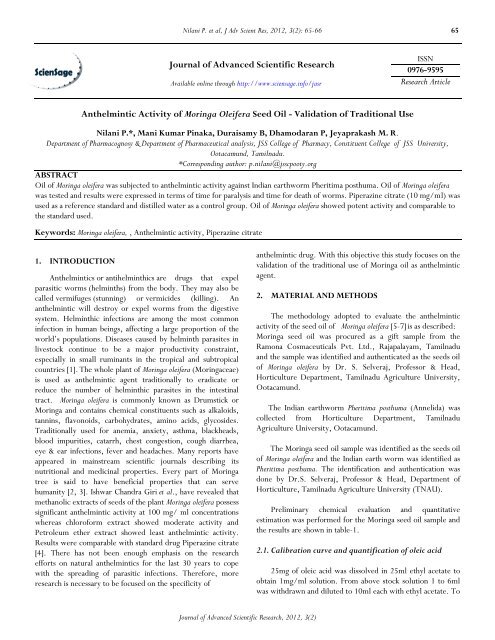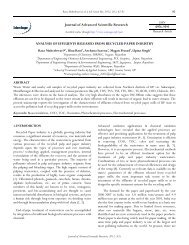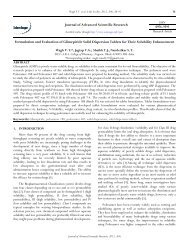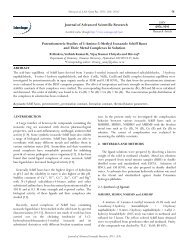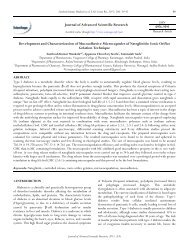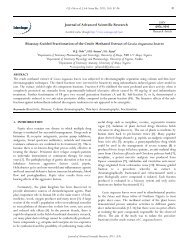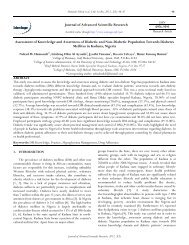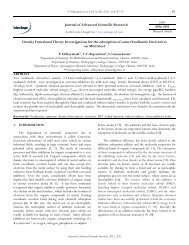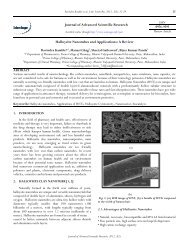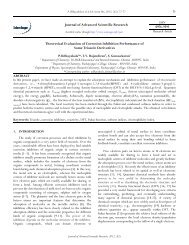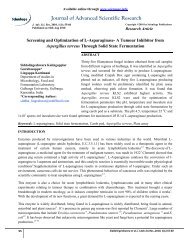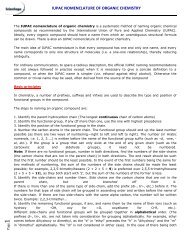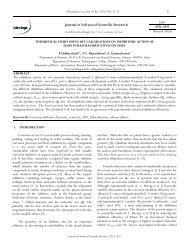Anthelmintic Activity of Moringa Oleifera Seed Oil - Sciensage.info
Anthelmintic Activity of Moringa Oleifera Seed Oil - Sciensage.info
Anthelmintic Activity of Moringa Oleifera Seed Oil - Sciensage.info
You also want an ePaper? Increase the reach of your titles
YUMPU automatically turns print PDFs into web optimized ePapers that Google loves.
Nilani P. et al, J Adv Scient Res, 2012, 3(2): 65-66 65<br />
Journal <strong>of</strong> Advanced Scientific Research<br />
Available online through http://www.sciensage.<strong>info</strong>/jasr<br />
ISSN<br />
0976-9595<br />
Research Article<br />
<strong>Anthelmintic</strong> <strong>Activity</strong> <strong>of</strong> <strong>Moringa</strong> <strong>Oleifera</strong> <strong>Seed</strong> <strong>Oil</strong> - Validation <strong>of</strong> Traditional Use<br />
Nilani P.*, Mani Kumar Pinaka, Duraisamy B, Dhamodaran P, Jeyaprakash M. R.<br />
Department <strong>of</strong> Pharmacognosy & Department <strong>of</strong> Pharmaceutical analysis, JSS College <strong>of</strong> Pharmacy, Constituent College <strong>of</strong> JSS University,<br />
Ootacamund, Tamilnadu.<br />
*Corresponding author: p.nilani@jsscpooty.org<br />
ABSTRACT<br />
<strong>Oil</strong> <strong>of</strong> <strong>Moringa</strong> oleifera was subjected to anthelmintic activity against Indian earthworm Pheritima posthuma. <strong>Oil</strong> <strong>of</strong> <strong>Moringa</strong> oleifera<br />
was tested and results were expressed in terms <strong>of</strong> time for paralysis and time for death <strong>of</strong> worms. Piperazine citrate (10 mg/ml) was<br />
used as a reference standard and distilled water as a control group. <strong>Oil</strong> <strong>of</strong> <strong>Moringa</strong> oleifera showed potent activity and comparable to<br />
the standard used.<br />
Keywords: <strong>Moringa</strong> oleifera, , <strong>Anthelmintic</strong> activity, Piperazine citrate<br />
1. INTRODUCTION<br />
<strong>Anthelmintic</strong>s or antihelminthics are drugs that expel<br />
parasitic worms (helminths) from the body. They may also be<br />
called vermifuges (stunning) or vermicides (killing). An<br />
anthelmintic will destroy or expel worms from the digestive<br />
system. Helminthic infections are among the most common<br />
infection in human beings, affecting a large proportion <strong>of</strong> the<br />
world’s populations. Diseases caused by helminth parasites in<br />
livestock continue to be a major productivity constraint,<br />
especially in small ruminants in the tropical and subtropical<br />
countries [1]. The whole plant <strong>of</strong> <strong>Moringa</strong> oleifera (<strong>Moringa</strong>ceae)<br />
is used as anthelmintic agent traditionally to eradicate or<br />
reduce the number <strong>of</strong> helminthic parasites in the intestinal<br />
tract. <strong>Moringa</strong> oleifera is commonly known as Drumstick or<br />
<strong>Moringa</strong> and contains chemical constituents such as alkaloids,<br />
tannins, flavonoids, carbohydrates, amino acids, glycosides.<br />
Traditionally used for anemia, anxiety, asthma, blackheads,<br />
blood impurities, catarrh, chest congestion, cough diarrhea,<br />
eye & ear infections, fever and headaches. Many reports have<br />
appeared in mainstream scientific journals describing its<br />
nutritional and medicinal properties. Every part <strong>of</strong> <strong>Moringa</strong><br />
tree is said to have beneficial properties that can serve<br />
humanity [2, 3]. Ishwar Chandra Giri et al., have revealed that<br />
methanolic extracts <strong>of</strong> seeds <strong>of</strong> the plant <strong>Moringa</strong> oleifera possess<br />
significant anthelmintic activity at 100 mg/ ml concentrations<br />
whereas chlor<strong>of</strong>orm extract showed moderate activity and<br />
Petroleum ether extract showed least anthelmintic activity.<br />
Results were comparable with standard drug Piperazine citrate<br />
[4]. There has not been enough emphasis on the research<br />
efforts on natural anthelmintics for the last 30 years to cope<br />
with the spreading <strong>of</strong> parasitic infections. Therefore, more<br />
research is necessary to be focused on the specificity <strong>of</strong><br />
anthelmintic drug. With this objective this study focuses on the<br />
validation <strong>of</strong> the traditional use <strong>of</strong> <strong>Moringa</strong> oil as anthelmintic<br />
agent.<br />
2. MATERIAL AND METHODS<br />
The methodology adopted to evaluate the anthelmintic<br />
activity <strong>of</strong> the seed oil <strong>of</strong> <strong>Moringa</strong> oleifera [5-7] is as described:<br />
<strong>Moringa</strong> seed oil was procured as a gift sample from the<br />
Ramona Cosmaceuticals Pvt. Ltd., Rajapalayam, Tamilnadu<br />
and the sample was identified and authenticated as the seeds oil<br />
<strong>of</strong> <strong>Moringa</strong> oleifera by Dr. S. Selveraj, Pr<strong>of</strong>essor & Head,<br />
Horticulture Department, Tamilnadu Agriculture University,<br />
Ootacamund.<br />
The Indian earthworm Pheritima posthuma (Annelida) was<br />
collected from Horticulture Department, Tamilnadu<br />
Agriculture University, Ootacamund.<br />
The <strong>Moringa</strong> seed oil sample was identified as the seeds oil<br />
<strong>of</strong> <strong>Moringa</strong> oleifera and the Indian earth worm was identified as<br />
Pheritima posthuma. The identification and authentication was<br />
done by Dr.S. Selveraj, Pr<strong>of</strong>essor & Head, Department <strong>of</strong><br />
Horticulture, Tamilnadu Agriculture University (TNAU).<br />
Preliminary chemical evaluation and quantitative<br />
estimation was performed for the <strong>Moringa</strong> seed oil sample and<br />
the results are shown in table-1.<br />
2.1. Calibration curve and quantification <strong>of</strong> oleic acid<br />
25mg <strong>of</strong> oleic acid was dissolved in 25ml ethyl acetate to<br />
obtain 1mg/ml solution. From above stock solution 1 to 6ml<br />
was withdrawn and diluted to 10ml each with ethyl acetate. To<br />
Journal <strong>of</strong> Advanced Scientific Research, 2012, 3(2)
this solution Zinc dust powder and Phenyl Hydrazine (an<br />
aldehyde detecting reagent) was added. The above diluted<br />
samples were subjected to analysis by using UV-<br />
Spectrophotometer (shimadzu-1700) at 515.5nm, the reading<br />
are tabulated and calibrated. The sample oil 5 ml was diluted<br />
to 10ml <strong>of</strong> ethyl acetate. To this solution Zinc dust powder and<br />
Phenyl Hydrazine was added and subjected to analysis.<br />
2.2. <strong>Anthelmintic</strong> <strong>Activity</strong><br />
As per the reference article (Qureshi Md. Shamim et al.)<br />
the earthworms <strong>of</strong> 3-5 cm in length and 0.1-0.2 cm in width<br />
were used for all the experimental protocol due to their<br />
anatomical and physiological resemblance with the intestinal<br />
roundworm parasites <strong>of</strong> human beings. Indian adult<br />
earthworms (Pheretima posthuma) were used for the<br />
anthelmintic study. Four groups <strong>of</strong> approximately equal sized<br />
Indian earthworms consisting <strong>of</strong> six earthworms in each group<br />
were released into 10 ml <strong>of</strong> extract and oil. Group one for<br />
control, receive only distilled water; Group two serve as<br />
standard, receive standard drug Piperazine citrate (10mg/ml) ;<br />
Group three for <strong>Moringa</strong> oil and Group four for Oleic acid<br />
.Observations were made for the time taken to paralysis and<br />
death <strong>of</strong> individual worms. Paralysis was said to occur when<br />
the worms did not revive even in normal saline. Death was<br />
concluded when the worms lost their motility followed with<br />
fading away <strong>of</strong> their body colours and the results are shown in<br />
table-2.<br />
3. RESULTS AND DISCUSSION<br />
<strong>Moringa</strong> oil at a concentration <strong>of</strong> 25mg/ml and 50 mg/ml<br />
showed death time <strong>of</strong> 30min and 24min and oleic acid<br />
(25mg/ml) showed death time <strong>of</strong> 33min Dose dependent<br />
activity confirms the potent anthelmintic activity <strong>of</strong> <strong>Moringa</strong><br />
oleifera seed oil . 72% Oleic acid in the oil <strong>of</strong> <strong>Moringa</strong> oleifera<br />
seeds was quantitatively estimated by UV spectral analysis<br />
.The study supports and validates the traditional use <strong>of</strong><br />
<strong>Moringa</strong> seed oil and further confirms that the oleic acid<br />
present in <strong>Moringa</strong> seed oil may also contributes to the<br />
traditionally claimed anthelmintic activity .<br />
Table 1: Standardization <strong>of</strong> <strong>Moringa</strong> oleifera seed oil<br />
Parameter Value Obtained<br />
Density(gm/ml) 0.895<br />
Refractive Index (at 40˚c) 1.457<br />
Viscosity (mPa.s) 45.1<br />
Saponification Value<br />
(mg <strong>of</strong> KOH/g oil)<br />
188<br />
Peroxide Value<br />
(meq <strong>of</strong> oxygen/Kg oil)<br />
65.6<br />
Iodine Value<br />
(g <strong>of</strong> Iodine/100g oil)<br />
1.83<br />
% <strong>of</strong> oleic acid 72<br />
Nilani P. et al, J Adv Scient Res, 2012, 3(2): 65-66 66<br />
Table 2: <strong>Anthelmintic</strong> study <strong>of</strong> <strong>Moringa</strong> oleifera seed oil-<br />
Comparative study<br />
Treatment Conc.<br />
(mg/ml)<br />
Paralysis time<br />
(min.)<br />
Death Time<br />
(min)<br />
Vehicle - - -<br />
Piperzine 10 22±1.5 40±1.5<br />
Citrate<br />
Oleic acid 25 23±0.5 33±0.5<br />
<strong>Moringa</strong> oil<br />
25 21±0.5<br />
30±0.5<br />
50 16±1.1<br />
24±1.1<br />
4. ACKNOWLEDGEMENT<br />
The author s are thankful to Ramona Cosmaceuticals Pvt.Ltd.,<br />
Rajapalayam, Tamilnadu , for providing good quality <strong>Moringa</strong><br />
seed oil as a gift sample for this study.<br />
5. REFERENCES<br />
1. Ching Chung Wang. Journal <strong>of</strong> Medicinal Chemistry, 1984;<br />
27(1):1.<br />
2. Qureshi Md. Shamim, Patel J, Venkateshwar RA, Syed Safiullah,<br />
Mohapatra P. Research J Pharmacology and Pharmacodynamics,<br />
2010; 2(2):183-186.<br />
3. Fahey JW. Trees for Life, 2005; 1:5.<br />
4. Srinivasu U, Amrutia Jay N, Katharotia Reena J. International<br />
Research Journal <strong>of</strong> Pharmacy, 2011; 2(8):130-131.<br />
5. Rastogi T et al, Asian J Research Chem, 2009; 2(2): 181.<br />
6. Ghosh T, Maity TK, Bose A, Dash GK, Indian J Nat Prodct,<br />
2005; 21:16-19.<br />
7. Mali RG, Mahajan SG Mehta AA. Phcog Mag, 2007; 3(10): 73.<br />
Journal <strong>of</strong> Advanced Scientific Research, 2012, 3(2)


